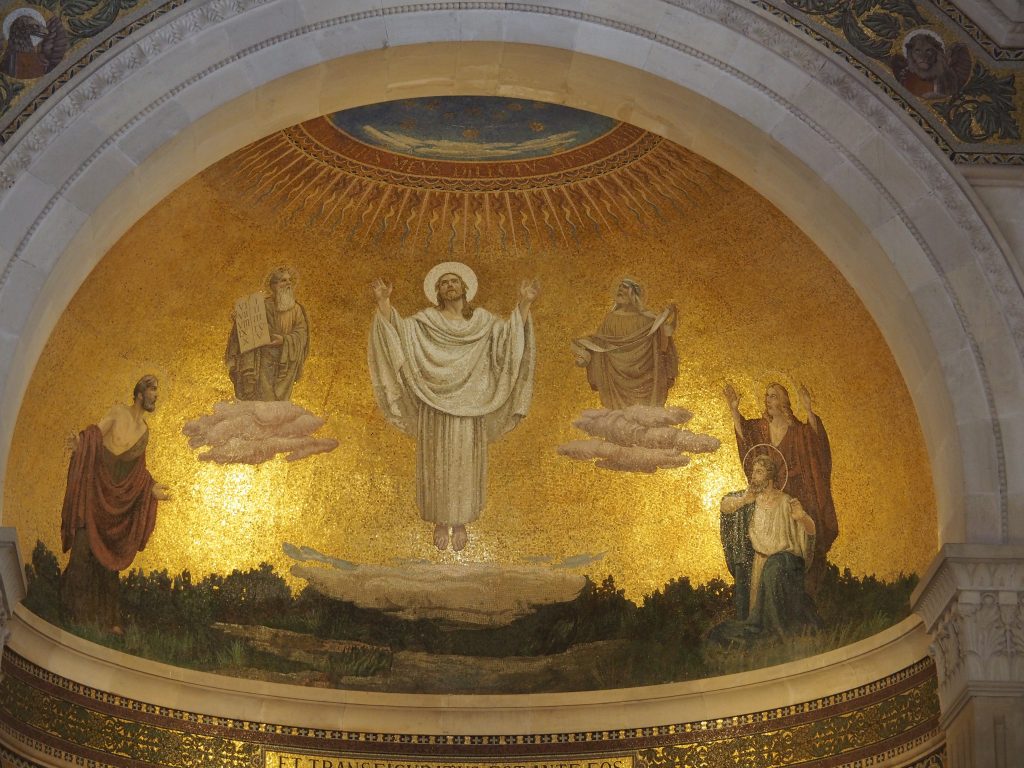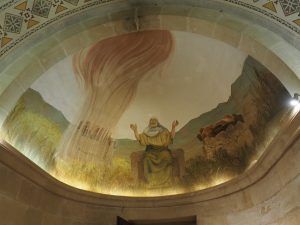Six days later, Jesus took with him Peter and James and his brother John and led them up a high mountain, by themselves. 2 And he was transfigured before them, and his face shone like the sun, and his clothes became dazzling white. 3 Suddenly there appeared to them Moses and Elijah, talking with him. 4 Then Peter said to Jesus, “Lord, it is good for us to be here; if you wish, I[a] will make three dwellings[b] here, one for you, one for Moses, and one for Elijah.” 5 While he was still speaking, suddenly a bright cloud overshadowed them, and from the cloud a voice said, “This is my Son, the Beloved;[c] with him I am well pleased; listen to him!” 6 When the disciples heard this, they fell to the ground and were overcome by fear. 7 But Jesus came and touched them, saying, “Get up and do not be afraid.” 8 And when they looked up, they saw no one except Jesus himself alone. [Matthew 17:1-8, NRSV]
The mosaic of transfiguration behind the main altar is here flanked by pictures of Moses and Isaiah from two side chapels of the Basilica of Transfiguration on Mount Tabor. [Photo credit: Dr. LL Chan]
Mount Tabor is the site of the Transfiguration of Jesus. Located 11 miles west of the Sea of Galilee, it rises from rather flat surroundings to a height of 1,886 feet. Jesus would have taken his time to climb the mountain on foot with Peter, James and John. We, however, were driven on a round trip by mini-vans operating as taxis up and down very steep and winding narrow roads.
Praying at the Basilica of the Transfiguration on Mount Tabor, we felt the importance of this event at this critical juncture of Jesus’ life, as he journeyed towards Jerusalem – towards his passion and death. He knew that his disciples, hamstrung as they were by visions of secular glories, would be utterly confounded to see him undergo torture and humiliated death. He knew too, that suffering would be their lot as well, if they kept to his path after he was gone. Blessed with the vision of the glory of his transfiguration, his disciples would be greatly encouraged and strengthened to face crises and persecution which were inevitably coming their way.
For ourselves, praying intensely in church, we were greatly encouraged to hold on to hope even when we were not sure things would get better. Hope is the reason not to give up; it is the reason not to surrender sanity and life. In the meantime, the narrative on the mountaintop transfiguration continued, as Jesus led their descent. Awaiting them were the human cries for relief which all disciples of Jesus must learn to redress well from the Master. They needed to focus, and pray, and persevere in prayers, always staying connected to the Source of life for grace to flow.
At the 10:00AM Mass we celebrated at the Basilica of the Transfiguration on Mount Tabor, Fr. Albert Jacobse preached the homily which is reproduced below.
—————————————–
Is it not true that when people call us by Hoi or hello, or boy or amoi or something else derogative, we do not feel exactly inclined to answer? But when we are called by our proper name, ha, that is something else, we know that we are recognized as an equal, as a human person and so we feel uplifted.
In today’s Gospel we hear the story of Jesus becoming radiant and aglow as he is recognized by God as: “my Son, the Chosen One.”
Jesus has had less success in being recognized by others. Because of what Jesus says and does, people begin asking questions about who he really is.
The neighbours think they know: “This is Joseph’s son surely”. Others are not so sure. The disciples ask: “Who is this who commands the waves?”
Jesus himself also promotes this question about himself by asking: “Who do people say I am?” …. “Who do you say I am?”
Nobody seems to get the answer right. Some say you are the prophet we have been waiting for, others say you are one of the prophets of the Old Testament. Of course no one will fully know who Jesus is until after the Resurrection.
Jesus goes up the mountain to pray together with three of his apostles Peter, James and John. He is seeking the guidance of God the Father in quiet prayer and as he prayed, he seemed to be fully taken up into another world.
In the experience of prayer it is clear that Jesus is not Elijah. Nor is he Moses. They appear on the scene to direct our attention to a journey Jesus must make to Jerusalem.
Peter makes a suggestion that echoes down the history: When in doubt, build!
But the focus is not on building, but on who Jesus is: “This is my son, the Chosen One. Listen to him.”
Is it any wonder that Jesus is aglow and radiant? He has an answer to his prayer. There is someone who gets his name right and that someone is his Father.
The Father doesn’t just recognize Jesus but recognizes him in love as his chosen one, and that transfigures Jesus. That recognition is connected with what Jesus must do: being who he is means that he must take the road to Jerusalem. And when Jesus comes down the mountain that is exactly what he does; he sets his face towards Jerusalem where he will come face to face with death.
The transfiguration enables Jesus to make the most difficult journey in his life – to take the road that leads to Calvary.
Transfiguration is not a solitary event in the Gospel but one that happens over and over again.
Throughout his public ministry Jesus transfigured many people — the broken, the wounded, the sinners and all those who were down and out, who had no name in society. He called to the deepest part of people and transfigured them by the power of God’s love, the same power that transfigured Jesus himself.
For Jesus that experience was getting close to who he really was. And we all get closer to who we really are when we hear our name called in love. When that happens we become uplifted, radiant. And we are enabled to face the future.
We can understand transfiguration better when we ask: what would it be like to transfigure us? What would it be like to transfigure the people we know? Who calls our name in love?
Whose name do we call in love?
All of us are in need of transfiguration. We become so taken up with everyday concerns of living that we often lose sight of the end to which we have been called. At times we are dragged down with feelings of failure and worthlessness. We seem not to be able to see light at the end of the tunnel. Sometimes our beautiful dreams are shattered, love is lost, a marriage breaks down. Our children walk a path we do not want them to go.
Suddenly there can be a piece of good news, a spark of joy, hope or love that changes our outlook and we see our lives in a new and better way.
We can be that good news to others, we can be that spark.
In our Lenten journey we are all asked to transfigure each other by the power of God’s love within us. We are all called to the ministry of transfiguration.
Copyright © Dr. Jeffrey & Angie Goh, October 2019. All rights reserved.
You are most welcome to respond to this post. Email your comments to jeffangiegoh@gmail.com. You can also be dialogue partners in this Ephphatha Coffee-Corner Ministry by sending us questions for discussion.



